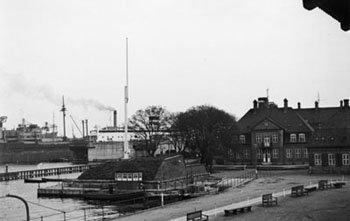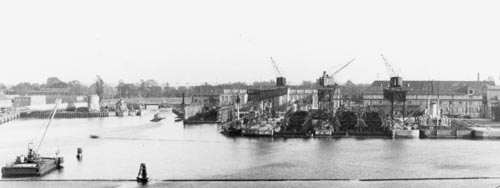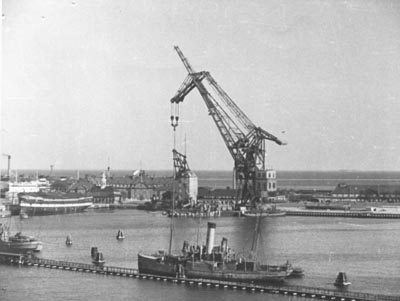|
|
|
The 2nd World War 1939-1945:
View of the Naval Dockyard in the days
after the scuttling of the navy.
(Photo: Royal
Danish Naval Museum)
Salvaging the scuttled Danish ships
Following the events on August 29
the Germans took over the Naval Dockyard
and started salvaging the scuttled ships
At the same time as the Danes refuse to
participate in the salvaging of the scuttled ships, they manage to destroy the
stored sea planes.
German floating crane succeeds in salvaging most of the Danish ships,
and 15 of those are incorporated into the German Kriegsmarine.
By
Søren Nørby, arts student
Following the scuttling of the navy, German
troops occupied the Naval Dockyard.
|
The Naval Dockyard was allowed to continue
production, but the yard still did not give in on the German pressure to build
and repair German naval units.
The Danish naval vessels under
construction at the yard were not completed, and they were all found at the
dockyard at the war's end.
Danish
Sea Planes destroyed
|

The Sovereign Flag at the SIXTUS
battery was stroked, however the German's chose not to fly the Swastika
instead.
(Photo: Royal
Danish Naval Museum) |
After the surrender in April 1940, the navel sea
planes had been stored at
the Naval Dockyard.
Shortly after August29th, 1943 the Germans removed
various tools and materials from the stores, but when they, at the end of
November, wanted to remove the planes, the Danes succeeded in burning the
buildings and thereby destroying the sea planes.
The German's take over the Naval Dockyard
On November 29th the German shipyard Howaldtswerke Inc, Hamburg, took
over control of the Naval Dockyard, but most of the Danish workers continued
working at the yard.

Holmen
in September, 1943.
In the center are the two T-41 torpedo boats under
construction
Notice at the right, the Royal Yacht
DANNEBROG in the dry dock, before it was moved to an other part of the
harbor.
In the left side is the submarine HAVFRUEN, put on land after being
salvaged September 8th.
(Photo: Royal
Danish Naval Museum)
The Germans promised that the Naval Dockyard was
only to work on civilian vessels, and that the yard was not expected to assist
in the raising of the scuttled Danish ships, or with the repair of German naval
units.
Danes refuse to assist
|
The Germans first tried to make the Danes raise the scuttled ships.
Arguing that the ships were Danish!
But when
the Danes refused, the Germans started raising the ships themselves.
On October 3rd, a large German floating crane, named Schwimmkran I/38, but called "Der Lange
Hendrik", crane arrived in Copenhagen, and was put to use bringing the ships
back to the surface.
15 ships ended up
in the German |

The German floating crane, Schwimmkran
I/38, also nicknamed "Der Lange Hendrik".
(Photo: Royal
Danish Naval Museum) |
Kriegsmarine
|

Aerial Photography of Holmen
January 1945 |
The Danish ships, not completely destroyed,
were towed to the B&W shipyard near by, where the were repaired before
entering tht German Kriegsmarine.
The Germans were able to raise most of the scuttled ships, and
a total af fifteen of
these were put into some kind of service by the German Kriegsmarine.
After the German take over of the Naval
Dockyard it continued to repair civilian German vessel, but the Danish
warships under construction, were not finished. |
The fate of the ships after August 29
Below is a list stating the dates on which the
Danish ships were salvaged.
The list is based on information from Anton Jacobsen, who in 1943 where
employed at the Naval Dockyard.
|To the Top

|
GEORG STAGE
(Sail training ship) |
Left the Royal Dockyard 15-9 for Svendborg. |
|
HEJMDAL
(patrol vessel) |
Raised 17-9. Towed to nearby private shipyard (Burmeister and Wain)
22-9. Returned to the Naval Dockyard 23-9.
Left the Naval Dockyard 28-10.
Hit by unknown explosion 30-10 while at Langelinie; one German sailor killed
and several wounded. |
|
SØHUNDEN
(minesweeper) |
Raised 20-9 and towed to B&W 23-9. |
|
MS
2
(minesweeper) |
Towed from the
Naval Dockyard 21-9. |
|
LINDORMEN (mine layer) |
Raised 1-10 and towed to B&W 14-10. Returned from B&W 22-10 and placed
by the Hønsebro. |
|
MS 8
(minesweeper) |
Raised 5-10. Towed to B&W 22-10. |
|
MS 10
(minesweeper) |
Placed on land 6-10 and returned to the water 11-10. Towed to B&W 22-10. |
|
H.2
HAVFRUEN (submarine) |
Raised 8-10 and placed on land.
Returned to the water the 3-12. Sank again 4-12 and raised again 6-12. |
|
MF.4
LAALAND (minelayer) |
Raised 11-10 and placed by the Hønsebro. |
|
R.2
MAKRELEN (guard ship) |
Raised 13-10. Broke in two and was placed on land the 14-10.
|
|
P.1
HVALROSSEN (guard ship) |
Raised 17-10. The keel broke and it was placed on land. |
|
MF.3
LOUGEN (minelayer) |
Raised 20-10. |
|
LOSSEN
(minelayer) |
Raised 22-10. Towed away 30-10. |
|
M.3
SØULVEN (minesweeper) |
Raised 24-10. |
|
HENRIK GERNER (tender) |
Raised 26-10. |
|
MF.2
SIXTUS
(minelayer) |
Raised 27-10. |
|
MF.1
KVINTUS (minelayer) |
Raised 29-10. |
|
Dannebrog
(Royal Yacht) |
Towed to Sydhavnen 29-10. |
|
C.3
FLORA (submarine) |
Raised 1-11. |
|
H.3
HAVKALEN (submarine) |
Raised 2-11. |
|
C.2
BELLONA (submarine) |
Raised 4-11. |
|
D.1
DAPHNE (submarine) |
Raised 5-11. |
|
H.4
HAVHESTEN (submarine) |
Raised 6-11. |
|
H.1
HAVMANDEN (submarine) |
Raised 8-11. |
|
C.1
ROTA (submarine) |
Raised 10-11. |
|
D.2
DRYADEN (submarine) |
Raised 12-11. |
|
M.2
SØBJØRNEN (minesweeper) |
The ship was placed upright on the 3-11 and raised on the 18-11. The
ship broke up during the attempt. The aft part of the ship broke off, and
was raised on the 22-11. The fore part of the ship was raised the 24-11 and
placed on land six days later.
SØBJØRNEN was raised with assistance from the Naval Dockyards own
steam-crane, which the Germans started using on the 1-11. |
|
R.5
SÆLEN
(guard ship) |
Raised 20-11 and placed on land 22-11. |
|
PEDER SKRAM (coast defense ship) |
Raised and baled out 22-11.
|
|
MS
4
(minesweeper) |
Raised 23-11 and placed on land 26-11. |
|
R.3
NORDKAPEREN (guard ship) |
Raised 26-11 and placed on land. |
|
NAJADEN and NYMFEN
(torpedo boats) |
Moved to the torpedobådsbroer 26-11.
|
|
Floating dock nr. 1. |
Raised 30-11. |
|
FREJA
(patrol vessel) |
Left the
Naval Dockyard 2-12 under German command and the new name SYDPOL. |
|To the Top

|
Sources: |
|
& |
Da
Danmarks Flaade blev sænket, by F. H. Kjølsen, Commander s.g.,
H. Hagerups Forlag, Copenhagen, 1945 |
 |
|
& |
Flådens Oprør, by Per Wessel
Tolvig (editor),
Marinehistoriske Skrifter, Copenhagen, 1953 |
 |
|
& |
Flådens skibe 1950, af R. Steen Steensen,
Det Schønbergske Forlag, København, 1950 |
 |
|
& |
Flaadens skibe den 29. august 1943,
og deres senere skæbne, by R. Steen Steensen,
article in "Tidsskrift for Søvæsenet", 1953 |
 |
|
& |
Flådens skibe og fartøjer 1945-1995, by Gunnar Olsen
and Svenn Storgaard, Marinehistoriske skrifter,
Copenhagen, 1998 (ISBN 87-87720-13-2) |
 |
|
& |
Operation K N U, Den danske flåde 29.
august 1943, by Hans Chr. Bjerg, article in "Tidsskrift for Søvæsenet", nr. 1, 1983 |
 |
|
& |
Orlogsværftets Særberetning
vedrørende Tiden fra 29. august 1943 til 31. marts 1944. |
 |
|
& |
Søværnet og dets personel 1940-45,
by Hans Chr. Bjerg, article in "Tidsskrift for Søvæsenet" nr. 1, 1998 |
 |
|
& |
Søværnets vilkår og virke under den
tyske besættelse april 1940 til august 1943, by S. S. v. F. Kieler, article in "Tidsskrift for Søvæsenet" nr. 1 og 2, 1993 |
 |
|
& |
Vore undervandsbåde gennem 50 år
(1909-1959), by R. Steen Steensen,
Munksgaards forlag,
Copenhagen, 1960 |
 |
|
44You are also referred to the
Naval Bibliography |

- Do you miss a major event on this Site,
or do you hold a great story?
Are you able to contribute to the unfolding of
the Danish Naval History,
please
e-mail
me, enclosures are welcome.
Please remember to list your sources.
You
can also use the
Naval
Web Forum on this web-site.

|To the Top

|
|
-
|





